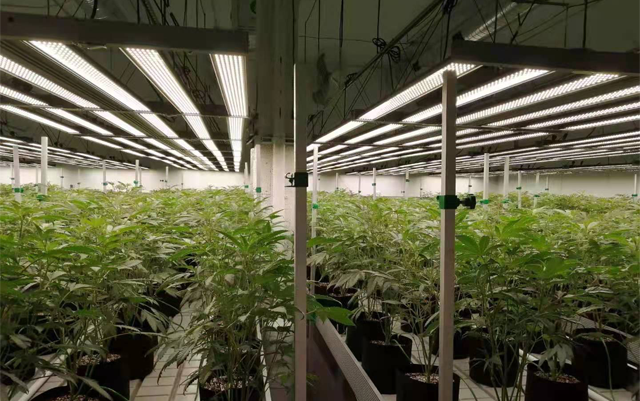The cannabis industry is still relatively young, but rapidly growing. The U.S. economic impact from marijuana sales in 2022 is projected to reach $99 billion, more than a 20% increase compared to 2021. Additionally, a recent job market report found that in January 2022, the cannabis industry now supports more than 428,000 full-time jobs in the U.S., up 33% in the previous 12 months.
As the industry continues to boom, competition will increase as more growers enter the market. With that influx of industry competition, growers will need to find ways to produce high quality plants that will reach maximum yields. By looking at grow room operations, growers can upgrade their equipment and practices to improve overall plant quality, starting with their lighting systems.
Grow lights are one of the most crucial aspects to growing cannabis. It is important for growers to educate themselves on the type of lights they are using. While many growers have initially used High Pressure Sodium (HPS) lights, more growers are making the switch to LED lights, or starting new grow rooms with LEDs, due to the benefits they provide.
If considering making the switch to LED grow lights, here are five things to consider:
1. Cost
When making the switch to LEDs, the first thought that might come to growers’ minds is cost. Grow lights are not a cheap addition for cannabis operations, especially when growing on a commercial scale. LEDs can be a more expensive alternative to HPS lighting solutions.
According to a State of the Cannabis Lighting Market report, when respondents were asked, “What is preventing your operation from introducing LED lights in the flower cycle within the next 12 months?” 33% said “challenges in securing funding/capital for LED lighting,” which was the most popular response.
While the upfront cost of LEDs may be pricey, it will be offset long-term. Not only will electricity bills read lower when using LED lighting, but growers will also qualify for rebates from their utility companies. Some grow light companies work with a third party to ensure growers are getting the maximum rebate possible for making the switch to LEDs.
2. 1:1 Replacement
Planning out a lighting solution for a grow operation is no easy task. Growers will need to work with lighting companies to map out the size of the room, the layout of the grow and configure how many fixtures are needed. Aside from installation, switching out lighting types in a grow room can be challenging and expensive, and may deter growers from making a switch from HPS to LEDs.
However, most LED grow lights are a 1:1 replacement to HPS solutions, meaning there is no need to spend money on additional light fixtures. For example, if a grow room uses 100 HPS grow lights, it will only need 100 LED grow lights to replace them. This will save growers time, money and headaches when it comes to making the switch.
3. Overall Plant Quality
The benefits of LED lights go beyond cost and replacement efficiency. One of the most important things to consider when making the switch to LEDs is the effect it will have on plants. Growers who use LEDs have seen an increase in the size of their plants, an increase in growth rate, and most importantly – better quality plants.
According to the State of the Cannabis Lighting Market report, LED grow lights remain popular across all stages of cannabis growth. 69% of respondents reported using LED lighting in propagation—up 48% from 2016’s report. 62% of respondents reported using LED lights in the vegetation stage (up 45% from 2016) along with the flowering stage (up 47% from 2016).
By improving size, growth and quality, growers can expect to receive a higher yield on their plants, making LEDs a popular choice and a worthy investment.
4. Customization
No two grows are the same – there are many variables that affect the type of equipment and practices growers use for their plants. Geographic location, cultivation methods (vertical/stacked, horizontal, etc.), grow room layout and other factors need to be considered when it comes to cannabis lighting.
LED light spectrums can be customized depending on a plant’s stage of growth. For example, red and far-red lights can be beneficial for the flowering phase, while blue light is good for green leaves and the veg stage of growth.
5. Sustainability
LED lights are largely known for their sustainability benefits. According to Sustainability Magazine, “LED lights are the most efficient lighting technology on the market, emit significantly less carbon, and are less harmful to people and the environment in the event of bulb breakage, due to LEDs’ lack of toxic mercury, which is present in some legacy lighting.”
When Journal of Cannabis Research completed a study in 2021, it found that cannabis plants use twice as much water as corn, soybeans, wheat and wine grapes. After discovering these environmental impacts, the cannabis industry is continuing to evolve with more sustainable practices, including the use of LED lighting.
According to a recent cannabis lighting market report, the industry is expected to grow at a compound annual growth rate (CAGR) of 8% from 2021-2026.
The cannabis industry is advancing every day, and while there are many variables for growers to consider, it can be agreed that one of the most crucial aspects in a cannabis grow is lighting. While grow light operations can change from grower to grower, LED lighting can be the foundation for quality plants and higher yields.






